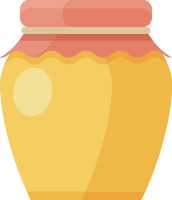Delicious Comb Honey!
Added by Kent Pegorsch on
Dancing Bear Honey's favorite honey to produce is comb honey. Fewer and fewer beekeepers raise comb honey because it is time consuming and takes a lot of "bee power" to produce. When beekeepers produce liquid honey, they typically spin the honey from the honeycomb and reuse the honeycombs year after year. This is efficient because the honeybees do not have to rebuild new combs every year.
When we harvest comb honey, we cut the comb containing the honey from the "frame" and the bees need to rebuild that comb the next year. The advantage is that you get the best tasting honey possible. As you bite into the comb or spread the comb onto your toast, you experience the full aroma and flavor of the honey!
Making comb honey starts with preparing the comb honey supers(boxes). Each box contains 10 frames that will hold the combs. We prepare those frames by installing a thin sheet of beeswax with the hexagonal imprint. These sheets are called foundation. Some beekeepers use only small starter strips of foundation but I like using full sheets because they give the end comb honey a more consistent look.


Preparing the supers (boxes) by installing foundation is great wintertime work. With a fire in the woodstove and a winter view out the window in front of my workbench, the summer seems a long way away.
And then the supers wait for Summer. 
One of the tricky parts of raising comb honey is picking the time to add the supers to the colonies. You want to add them just as a strong nectar flow starts. In our part of Wisconsin, trees (Locust and Basswood) and flowers (Dutch Clover, Sweet Clover, Spotted Knapweed, etc.) provide nectar for the bees in June and July. The nectar is collected by the bees, brought back to the colony and evaporated into honey. Even though each source blooms at about the same time each year, the strongest nectar flow can vary by weeks or not even happen due to weather.
If the supers are added too soon, the bees will chew off the foundation and may never store honey in the supers preferring the existing combs used in the supers that are for extracting liquid honey. If added too late, the comb honey may never be completed by the bees and the combs will need to be extracted for liquid honey, combs melted out and new foundation installed again for next year.
Comb honey supers are added only to the strongest colonies. In this photo, you see the yellow comb honey supers mixed with the white supers that will be extracted for liquid honey. As the season progresses, we may move the comb honey supers from one colony that isn't interested in working in the super to another colony that is filling supers. The process of the bees building comb on the foundation is called "drawing out the comb". Having hives that are strong enough and interested in drawing out comb is an important step to producing comb honey.

Here are two combs or frames of comb honey. The first one has not been fully capped over by the bees. We will leave that frame on the colony for a week or two longer hoping that they finish the cappings.

This comb is completely capped and ready to be harvested
Then we bring the frames of comb honey back to the honey house to cut the comb honey and package it. 
Here is a short video of how simple the process is:
After the comb honey is cut into sections, the sections are drained.
The final step is packing the comb honey sections into boxes. To get honey any fresher, you would have to be a honeybee!
Available at Main Street Marketplace - Downtown Waupaca or online at
https://dancingbearhoney.com/products/comb-honey
https://mainstreetwaupaca.com/products/comb-honey


